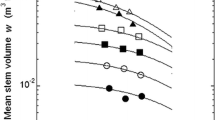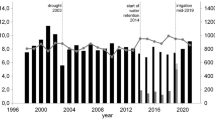Stand dynamics and self-thinning were analyzed in relation to the dynamics of above-ground biomass in natural Abies sachalinensis stands growing on sand dunes in northern Hokkaido, Japan. This was done in order to examine wave-type regeneration in the stands. Fifty-two plots were established in almost pure Abies stands that ranged from saplings to the mature and collapsing growth stages. Above-ground biomass and tree height reached asymptotic levels prior to the collapsing phase, unlike wave-regeneration Abies stands in central Japan and North America. Stand density was high in the young growth stages, but the self-thinning rate, that is, the density decrease per biomass growth in the study stands was greater than in wave-regeneration stands in central Japan, as indicated by a large self-thinning exponent (−1.26 by reduced major axis regression). The range of tree height distribution was very narrow, and the stands’ vertical structure was typically single-layered. The slenderness ratio of trees was large, except in young stands. In mature and collapsing stands, advanced seedling density increased markedly. These stand and tree characteristics were considered to be correlated with the wave-type regeneration in the study stands, and it is assumed that prevailing winds affect tree mortality.
Similar content being viewed by others
References
Brand D. G. & Magnussen S. (1988) Asymmetric, two-sided competition in even-aged monocultures of red pine. Canadian Journal of Forest Research 18: 901–910.
Berg E. E. & Chapin F. S. III (1994) Needle loss as a mechanism of winter drought avoidance in boreal conifers. Canadian Journal of Forest Research 24: 1144–1148.
Hara T. (1988) Dynamics of size structure in plant populations. Trends in Ecology and Evolution 3: 129–133.
Hepp T. E. & Brister G. H. (1982) Estimated crown biomass in loblolly pine plantations in the Carolina flatwoods. Forest Science 28: 115–127.
Kai K. (1974) Some aspects of the Shimagare phenomenon in the subalpine forests in the Kanto and the Chubu districts, Japan. Geographical Review of Japan 47: 709–718 (in Japanese with English summary).
Kijima T., Okamoto S. & Hayashi S. (1962) Atlas of wood in colour. Hoikusha, Tokyo (in Japanese).
Kimura M. (1984) Memories and records in forest study. The Heredity 38: 40–42 (in Japanese).
Kohyama T. (1984) Regeneration in Abies veitchii-A. mariesii forest in subalpine zone The Heredity 38: 67–72 (in Japanese).
Kohyama T. (1988) Etiology of ‘Shimagare’ dieback and regeneration in subalpine Abies forests of Japan. Geojournal 17: 201–208.
Kohyama T. & Fujita N. (1981) Studies on the Abies population of Mt. Shimagare I. Survivorship curve. Botanical Magazine Tokyo 94: 55–68.
Leduc D. J. (1987) A comparative analysis of the reduced major axis technique of fitting lines to bivariate data. Canadian Journal of Forest Research 17: 654–659.
Manabe A. (1974) Stand density control diagram for Abies sachalinensis. Hoppo Ringyokai, Sapporo (in Japanese).
Marchand P. J., Goulet F. L. & Harrington T. C. (1986) Death by attrition: a hypothesis for wave mortality of subalpine Abies balsamea. Canadian Journal of Forest Research 16: 591–596.
Mohler C. L., Marks P. L. & Sprugel D. G. (1978) Stand structure and allometry of trees during self-thinning of pure stands. Journal of Ecology 66: 599–614.
Oka S. (1983) Reconsideration on the distribution of the Shimagare phenomenon in Japan. Journal of Geography 92: 219–234 (in Japanese with English summary).
Osawa A. & Allen R. B. (1993) Allometric theory explains self-thinning relationships of mountain beech and red pine. Ecology 74: 1020–1032.
Richards F. J. (1959) A flexible growth function for empirical use. Journal of Experimental Botany 10: 290–300.
Sato T. (1994) Stand structure and dynamics of wave-type Abies sachalinensis coastal forest. Ecological Research 9: 77–84.
Sato K. & Iwasa Y. (1993) Modeling of wave regeneration in subalpine Abies forests: Population dynamics with spatial structure. Ecology 74: 1538–1550.
Shibuya M. & Matsuda K. (1993) Biomass estimations of aerial organs of natural white birch trees. Research Bulletin of the Hokkaido University Forests 50: 207–218 (in Japanese with English summary).
Shimazu A. (1959) On the origin of ‘dead tree stripes’ in the subalpine forest of the Yatsugatake I. Relationship between its distribution and prevailing wind. Natural Science Report Ochanomizu University 10: 69–83 (in Japanese with English summary).
Sprugel D. G. (1976) Dynamic structure of wave-regenerated Abies balsamea forests in the north-eastern United States. Journal of Ecology 64: 889–911.
Sprugel D. G. (1984) Density, biomass, productivity, and nutrient-cycling changes during stand development in wave-regenerated balsam fir forests. Ecological Monographs 54: 165–186.
Tadaki Y., Sato A., Sakurai S., Takeuchi I. & Kawahara T. (1977) Studies on the production structure of forest. XVIII. Structure and primary production in subalpine ‘dead tree stripes’Abies forest near Mt. Asahi. Japanese Journal of Ecology 27: 83–90 (in Japanese with English summary).
Westoby M. (1984) The self-thinning rule. Advances in Ecological Research 14: 167–225.
Yajima T. (1982) Study on the growth of main tree species in the mixed forest of needle-leaved and broad-leaved trees. Research. Bulletins of the College Experiment Forests, Hokkaido University 39: 1–54 (in Japanese with English summary).
Yoda K., Kira T., Ogawa H. & Hozumi K. (1963) Self-thinning in overcrowded pure stands under cultivated and natural conditions. (Intraspecific competition among higher plants XI). Journal of Biology, Osaka City University 14: 107–129.
Zavitkovski R., Jeffers M., Ninestaedt H. & Strong T. F. (1981) Biomass production of several jack pine provenances at three Lake States locations. Canadian Journal of Forest Research 11: 441–447.
Zeide B. (1991) Self-thinning and stand density. Forest Science 37: 517–523.
Author information
Authors and Affiliations
Corresponding author
About this article
Cite this article
SHIBUYA, M., HAGA, N., SASAKI, T. et al. Stand and self-thinning dynamics in natural Abies stands in northern Hokkaido, Japan. Ecol Res 19, 301–309 (2004). https://doi.org/10.1111/j.1440-1703.2004.00639.x
Received:
Accepted:
Issue Date:
DOI: https://doi.org/10.1111/j.1440-1703.2004.00639.x




